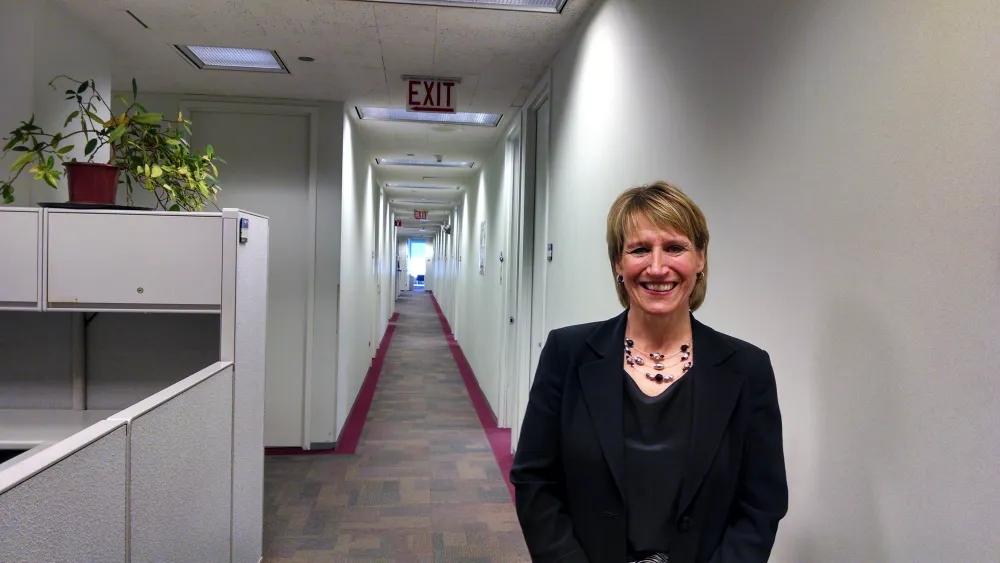Federal courts have reduced the space they occupy, cutting associated rent costs at facilities throughout the country.

A new open central space in the District of Maryland (Greenbelt) courthouse was part of a redesign that avoided construction of a proposed annex. Judicial Assistant Sharon Townsend, foreground, speaks with Valerie Sutton, a space and facilities specialist.
Judiciary Footprint Reduced
In 2013, the Judicial Conference approved three space-reduction policies: a “No Net New” policy; a national 3 percent space-reduction target by the end of fiscal year 2018; and a directive that each circuit judicial council formulate a space and rent management plan for implementing space reductions. Each circuit submitted its initial plan in May 2014. As of September 2015, there were a total of 376 space-reduction projects, of which 157 were completed, with a net reduction of more than 437,182 square feet. This represents 35 percent of the national target, with every circuit expecting to meet or exceed its goal by the end of fiscal year 2018. Circuit, district, bankruptcy courts and probation and pretrial services offices reduced their footprint in 2015. Among the projects:
- In the Southern District of Texas, a design project is underway for Houston’s Bob Casey Courthouse that will result in a major reduction in space estimated at 20,000 useable square feet or more, while ensuring a more attractive and efficient workplace environment. Meanwhile, the Probation Offices in Laredo—currently in two locations—will be relocated to the federal courthouse for more efficient operations, and a substantial reduction in space.
- Space used by the Miami district and bankruptcy courts in a U.S. courthouse has been consolidated, allowing the release of approximately 31,000 useable square feet, with an annual rent savings of $900,000.
- In the Third Circuit’s Philadelphia headquarters, three existing judges’ chambers are being renovated to accommodate 12 visiting judges and staff in lieu of expansion into a new courthouse. This avoids approximately $6 million that would otherwise have been needed to construct four judges’ chambers, plus approximately $240,000 in annual rent.
- In the Eastern and Western Districts of Michigan, the AO is working with Grand Rapids and Detroit bankruptcy courts and with the Marquette court facility on space-reduction analyses of their spaces. A probation office reduction project is being added to the renovation planned for the Theodore Levin Courthouse in Detroit.
- In the Northern District of Illinois, the AO assisted the Probation Office with technical support for the digital conversion of paper records at the Chicago, Lisle, and Rockford locations in conjunction with the Chicago space-reduction project by converting paper records to a digital format.
- The Tenth Circuit has reduced approximately 38,620 usable square feet through space reduction projects. Combined with ongoing projects, this will result in a net reduction of approximately 60,000 usable square feet.
- In the District of New Mexico, a realignment and space-reduction project involving the Albuquerque district and bankruptcy courts and the circuit library will save an estimated $900,000 in annual rent and security charges.
- The Eastern District of New York Bankruptcy Court has released more than 10,000 useable square feet for an estimated $900,000 in rent savings.
- The District of Maryland (Greenbelt) overcame a crowding problem and avoided the need for a proposed annex by building a suite in existing space to house five judges' chambers, and a new Central Violations Bureau courtroom to handle a large traffic docket, along with a new courthouse entryway.
Judiciary’s Top Building Priority Included in FY 2016 Budget Request
In February 2015, the President’s fiscal year 2016 budget request to Congress included $188 million under the GSA for the new courthouse construction project in Nashville, TN, the Judiciary’s top priority on its Five-Year Courthouse Project Plan for Fiscal Years 2016-2020 (Five-Year Plan). This is only the second time since fiscal year 2010 that a project on the Judiciary’s Five-Year Plan has been included in the President’s budget request.
Subsequently, the Consolidated Appropriations Act of 2016 provided $948 million in lump sum funding to the General Services Administration for the construction of the top eight courthouses on the Judiciary’s current Courthouse Project Priorities (CPP) plan.
New Courthouse Plan Reflects Construction Priorities
In September 2015, the Judicial Conference approved a recommendation by the Committee on Space and Facilities for a new planning instrument, the Federal Judiciary Courthouse Project Priorities (CPP), detailing the Judiciary’s priorities for new courthouse construction. The previous planning instrument, the Five-Year Courthouse Project Plan, prioritized courthouse projects through five fiscal years, but did not fully reflect funding timelines, or the relative urgency of projects on the plan.
The new CPP maintains the priority order of all projects included on last year’s Five-Year Plan, but presents them in a two-part document designed to better manage stakeholder expectations, respond to congressional inquiries, and address GAO recommendations. Part I presents the Judiciary’s “current year” courthouse construction priorities. Going forward, the priority order of all courthouse projects on Part I will be maintained until a project has been fully funded. Freezing the priority of these projects is intended to provide stability and predictability for GSA as it seeks funding and proceeds with project design, site acquisition, and construction. Part II consists of a separate list of projects previously listed in the former Five-Year Plan. This part will be reviewed and updated annually according to the project’s urgency of need.
Final Report Issued on GSA Service Validation Initiative
In June 2015, the Judicial Conference Committee on Space and Facilities received the final report on the General Services Administration Service Validation Initiative. This collaborative effort between the Judiciary and the GSA is designed to improve GSA service delivery to the Judiciary. The report recommended new policies, practices, tools, and resources, as well as additional training of court staff and GSA service-center employees. The joint recommendations address how Judiciary rent is calculated, how appraisals are conducted, how disputes are resolved, how overtime utilities are billed, and how projects are estimated and managed. Action teams have been established, staffed, and tasked with carrying out the recommendations.
A joint Judiciary-GSA national training program will be conducted by region during fiscal year 2016. The target audience will be all GSA and court unit staff involved in space management, with a curriculum designed for both executives and service-level staff.
Capital Security Program Addresses Security Issues
The Capital Security Program (CSP) helps the Judiciary and GSA address security deficiencies in existing court facilities where physical alterations are viable. The goal is to improve security by renovating courthouses in locations that have not been recommended for new courthouse construction or where near-term funding is unlikely for a major renovation project.
To date, two CSP projects have been completed, in Benton, IL in January 2015, and Hato Rey, Puerto Rico in August 2015. The Benton project addressed security deficiencies by reconfiguring corridors and constructing new ones, adding an elevator, enclosing a sally port, and constructing visual barriers. The Hato Rey project addressed security deficiencies by adding two new elevators, providing secured circulation, constructing an elevator sally port, and installing additional security equipment.
Two additional CSP projects in Brunswick, GA; and Lexington, KY, are under construction and four are under design in St. Thomas, VI; Columbus, GA; Monroe, LA; and Texarkana, TX/AR.
The Consolidated Appropriations Act of 2016 provided $20 million for the CSP, the same amount Congress appropriated for the CSP in fiscal year 2015.
Integrated Workplace Initiative Projects Debut
A number of Integrated Workplace Initiative projects began in 2015, following the Judicial Conference endorsement in 2014 of a new U.S. Courts Design Guide chapter advancing the Judiciary’s Integrated Workplace Initiative (IWI) and other space and rent reduction efforts. The IWI is designed to reduce the Judiciary’s footprint and create a better and more efficient workplace environment by capitalizing on the flexibility afforded by new and emerging technologies. IWI examines how court units work, researches work style changes, and identifies successful mobile working situations (e.g., probation officers working in the field rather than in the courthouse). Examples of IWI projects underway include the following:

Jeanne Walsh, Chief U.S. Probation Officer for the Northern District of Illinois, said her current office layout, with long halls and private offices, no longer suits a downsized staff that spends many hours in the field.
- Relocating the Chicago probation office from two leased floors to a floor in the federal courthouse will reduce space requirements by more than 59 percent, improve security, incorporate IWI mobility in response to many officers travelling to their clients, and realize $1.4 million in annual rent savings. This project is in the construction phase, with occupancy anticipated in November 2015.
- Relocating the Phoenix probation office to the federal courthouse and reducing the amount of space occupied will save 7,200 of usable square feet and $300,000 every year in rent. The project is in the design phase, with occupancy anticipated in 2016.
- Consolidating the AO’s Facilities and Security Office into one space in the Thurgood Marshall Federal Judiciary Building will reduce space use by approximately 23 percent using IWI-mobility concepts. The project will serve as a model for court units that may be interested in undertaking similar projects. Currently under design, occupancy is anticipated in 2017.
Courthouse Physical Access Control Systems Under Review
An independent review began in July 2015 of the Physical Access Control Systems (PACS) that provide secure access to courthouses nationwide. The Judicial Conference Judicial Security Committee called for this study to identify technology, procurement, and program management staffing strategies to sustain and/or replace the courthouse PACS. The results of this independent study, funded through the Court Security appropriation, was completed in December 2015 for consideration at the Committee’s January 2016 meeting, in conjunction with the U.S. Marshals Service’s recommendations for new investments in PACS.
Facility Access Cards Implementation Nearly Complete
The Facility Access Card (FAC) is now in use in approximately 230 court facilities in 57 districts and four circuits, with more than 13,000 FACs issued to judges and court personnel. FAC is the Judiciary’s version of the Personal Identity Verification (PIV) card mandated by the 2004 Homeland Security Presidential Directive 12. While the directive does not apply to the Judicial Branch, the Judicial Conference endorsed the Judiciary’s participation, as courts are housed in facilities owned or controlled by the executive branch and are protected by executive branch entities.
The FAC project is mandatory for all court units and will provide every Judiciary employee with a personal identity verification card.
Annual Report 2015
- Annual Report 2015
- Funding/Budget
- The Courts and Congress
- The Federal Bench in 2015
- Accountability and Resource Utilization
- Facilities and Security
- Public Outreach
- Court Operations and Case Management
- Defender Services
- Probation and Pretrial Services
- Financial and Human Resource Initiatives
- Information Systems and Cybersecurity
- Recent and Proposed Amendments to the Federal Rules
- In Profile
